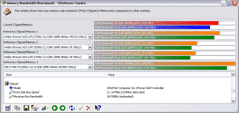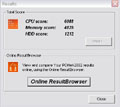|
 Posted: October 21, 2003 Posted: October 21, 2003
Author: Jason Kohrs
Manufacturer: Crucial
Source: Crucial
Crucial, a division of Micron Technology, may have recently branched out into the video card and flash drive markets, but they are best known as one of the leaders in system memory upgrades. Crucial has a solid reputation for quality that they have earned with trustworthy products backed by a 30-day money back guarantee, and a lifetime limited warranty. Recently Crucial allowed one of their engineers to discuss their memory with us in an interview, and today we’re taking a closer look at some of their memory, two sticks of 256 MB PC3200 DDR.
 The Crucial DDR arrived in the package as shown on the left. Each stick is sealed in its own anti-static bag, and separated / protected by the unique folds of cardboard seen. Once out of the anti-static bags, I had the two identical sticks of 184-pin DDR as pictured in the below left image. Each stick is identified and bar-coded with two stickers that cover a large percentage of all the chip’s surface area. Full details of the markings are visible in the images below, with close ups shown in the center and right images. The Crucial DDR arrived in the package as shown on the left. Each stick is sealed in its own anti-static bag, and separated / protected by the unique folds of cardboard seen. Once out of the anti-static bags, I had the two identical sticks of 184-pin DDR as pictured in the below left image. Each stick is identified and bar-coded with two stickers that cover a large percentage of all the chip’s surface area. Full details of the markings are visible in the images below, with close ups shown in the center and right images.
  
 Crucial, as a division of Micron Technology, has the advantage of being able to use their own chips. As learned in the Crucial Interview, “When you buy Crucial RAM, you’re buying from a company with more than 20 years of industry experience and the only consumer memory upgrade supplier that is part of a major DRAM manufacturer.” As shown in the image on the right, you can see the “MT” marking that indicates that this chip was manufactured by Micron Technology. Crucial, as a division of Micron Technology, has the advantage of being able to use their own chips. As learned in the Crucial Interview, “When you buy Crucial RAM, you’re buying from a company with more than 20 years of industry experience and the only consumer memory upgrade supplier that is part of a major DRAM manufacturer.” As shown in the image on the right, you can see the “MT” marking that indicates that this chip was manufactured by Micron Technology.
The published specifications are shown below (as taken from the Crucial website):
|
4Module Size: 256 MB
4Package: 184-pin DIMM
4Feature: DDR PC3200
4Configuration: 32Meg x 64
|
4Error Checking: Non-parity
4Speed: 5ns
4Voltage: 2.5V SDRAM
4Timings:CL=3
|
|
Most people familiar with using “performance” DDR may see that CAS Latency of 3.0, and be less than impressed. Upon my first boot with the Crucial memory installed, I entered the BIOS to see that SPD detected the memory timings as 8-3-3-3 3.0. As a point of reference, the GeiL PC3200 recently reviewed at BigBruin.Com sported timings of 6-3-3-2 2.0 (lower is better). During testing I will manually adjust these settings to find the optimal settings for speed and stability, and see if the Crucial DDR is perhaps capable of more than it will admit.
One thing that Crucial makes very clear is that they don’t support overclocking! An excerpt from the interview conducted at BigBruin.Com further emphasizes that point: “Crucial memory is designed to JEDEC standards to meet the needs of the majority of the market--the mainstream computer user. Though our high-quality memory is certainly used by the “performance” market, we do not support overclocking. Running Crucial memory outside of the specification will void the Crucial warranty.”
Even if they don’t support overclocking, I feel obliged to try, and will hope for the best!
Testing:
The system used for testing consisted of the following components:
4AMD Athlon XP2200+ Processor
4Shuttle AN35N Ultra nForce2 Ultra 400 Motherboard
4(2) Maxtor 40GB ATA-133 Hard Drives
4Lite-On CD-RW Drive
4Artec DVD Drive
4Allied AL-B500E 500W Power Supply
4Windows XP Professional SP1
Two common benchmarks were run on the Crucial memory, SiSoft Sandra Max3! and PCMark 2002. Each of these programs provide details about the memory’s performance that can be used to compare to reference results, or directly with other memory you might have for use on the same system. While running the benchmarks, I had two goals in mind. The first being to see how low I could get the timings while running the memory at the default speed of 400 MHz. The second was to see how high I could overclock the memory, regardless of the timings.
Sisoft's Sandra 2003, which stands for System ANalyser, Diagnostic and Reporting Assistant, "is an information & diagnostic utility. It should provide most of the information (including undocumented) you need to know about your hardware, software and other devices whether hardware or software." It is a comprehensive program with a suite of thorough benchmarks that is available in one form as a free download. Sandra’s memory benchmark module provides two results, with units of MB/s, obtained by reading/writing large chunks of data to memory.
FutureMark's PCMark2002 "is a completely new, multipurpose benchmark, suited for benchmarking all kinds of PCs, from laptops to workstations, as well as across multiple Windows operating systems." Available as a free download, anyone can test their system and use FutureMark's online result browser to see how they stack up with the outside world. The results as they relate to the memory are provided as a single number, with the units referred to as “Marks”.
The DDR voltage was held constant during testing at 2.6V, while other timings and speeds were varied as detailed in the table below. On the right side of the table are the resulting scores achieved in the respective benchmarks.
|
Memory Benchmark Results
|
|
Sticks
|
FSB (MHz)
|
DDR (MHz)
|
Timings
|
Sandra Integer (MB/s)
|
Sandra Float (MB/s)
|
PCMark 2002
|
|
1
|
133
|
400
|
8-3-3-3 3.0
|
2008
|
1913
|
3788
|
|
2
|
133
|
400
|
8-3-3-3 3.0
|
2024
|
1932
|
3881
|
|
1
|
133
|
400
|
6-3-3-3 2.5
|
1998
|
1901
|
3816
|
|
2
|
166
|
400
|
6-3-3-3 2.5
|
2498
|
2302
|
4425
|
|
1
|
133
|
400
|
6-3-3-3 2.0
|
FAIL
|
FAIL
|
FAIL
|
|
2
|
166
|
444
|
6-3-3-3 3.0
|
2529
|
2329
|
4510
|
|
2
|
169
|
450
|
6-3-3-3 3.0
|
2561
|
2361
|
4567
|
|
2
|
175
|
466
|
6-3-3-3 3.0
|
2657
|
2448
|
4719
|
|
2
|
160
|
480
|
6-3-3-3 3.0
|
FAIL
|
FAIL
|
FAIL
|
|
The table above shows that with an increased frontside bus speed (FSB), and the memory speed held constant, the benchmarks reap the benefits across the board. When I tried to boot the computer with the timings set to 6-3-3-3 2.0, I could only get BIOS error beeps, and realized that I had reached the timing limit of these chips at 6-3-3-3 2.5. Decent timings, but definitely not the best as compared to “performance” brand DDR. However, the benchmarks are quite impressive. As compared to similar memory on similar motherboards in SiSoft Sandra's reference listing, the scores are very respectable. Even when compared to the "performance" DDR from GeiL mentioned previously, the results are only off by a very small percentage, despite the CAS Latency being run at 3.0 as compared to 2.0 and 2.5 with the GeiL. If I was capable of achieving a frontside bus speed of 200 MHz, the results would have been even more impressive as memory benchmarks definitely benefit from having the frontside bus running synchronously with the memory bus.
The two images below provide screen shots of the maximum results achieved in each benchmark while running the 2 sticks of Crucial PC3200 DDR at 175 MHz fsb and 466 MHz DDR...
 
Click Images Above to View Highest Benchmarks
The Crucial PC3200 DDR has proven itself as a worthy choice for people looking for rock solid performance at default speed and timings, and surprisingly also allows for some impressive overclocking (if you're willing to jeopardize your warranty). The maximum speed of 466 MHz DDR achieved during testing translates to a speed rating equivalent to PC3700, which is far higher than I would have imagined they could go. For those who insist that the copper heatspreaders found on "performance" DDR are a necessity, I'd like to point out that although the chips got warm during testing at 466 MHz DDR, they never got hot enough that I couldn't comfortably leave my finger on them for an extended period.
The 256 MB modules tested are available directly from Crucial for $48.95 (which includes FREE second day delivery), making the price highly competitive with other brands available elsewhere online. A quick look at prices for 256 MB PC3200 DDR memory modules on PriceGrabber shows that you won't do any better, especially once you consider shipping into the total cost. Factor in the lifetime limited warranty and excellent customer service, the Crucial PC3200 DDR can easily be considered a highly recommended product and earns five out of five stars.

Pros:
4Stable and reliable
4Provides excellent performance
4Competitively priced
4Lifetime warranty
4Free shipping
Cons:
4Not intended / recommended for overclocking (but is obviously capable)
4Does not provide the fastest timings
Special thanks to Crucial for providing the two 256 MB sticks of PC3200 DDR memory for review!
Please drop by the BigBruin.Com Forum and feel free to discuss this review.
|